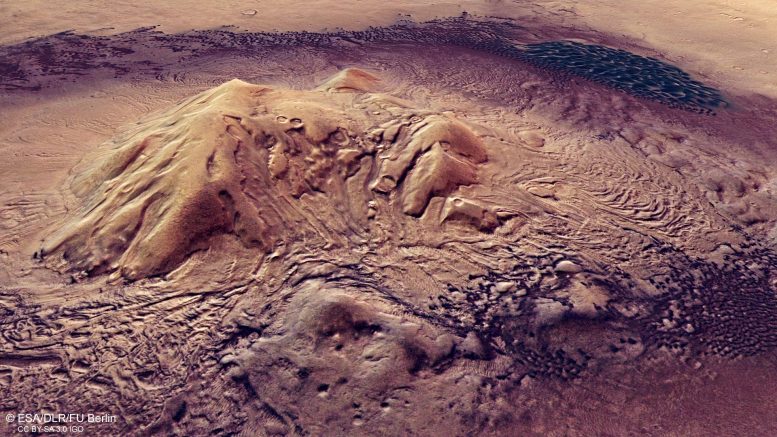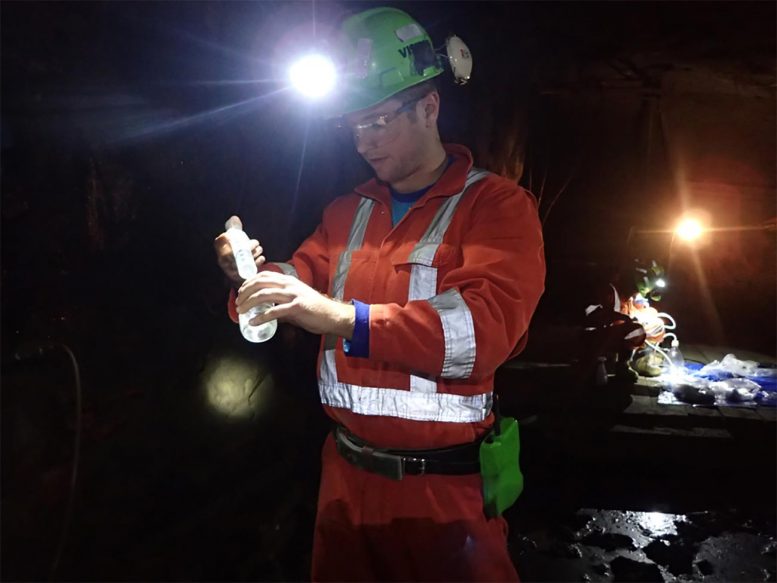Life on Mars? Scientists Find Mars Has Right Ingredients for Present-Day Microbial Life Beneath Its Surface
- Get link
- X
- Other Apps
TOPICS:AstrobiologyBrown UniversityGeologyMarsPlanetsPopular
By BROWN UNIVERSITY APRIL 23, 2021

Image of the surface of Mars (Moreux crater taken by the Mars Express orbiter. Credit: ESA/DLR/FU Berlin, CC BY-SA 3.0 IGO
New research suggests that rocks in the Martian crust could produce the same kind of chemical energy that supports microbial life deep beneath Earth’s surface.
As NASA’s Perseverance rover begins its search for ancient life on the surface of Mars, a new study suggests that the Martian subsurface might be a good place to look for possible present-day life on the Red Planet.
The study, published in the journal Astrobiology, looked at the chemical composition of Martian meteorites — rocks blasted off of the surface of Mars that eventually landed on Earth. The analysis determined that those rocks, if in consistent contact with water, would produce the chemical energy needed to support microbial communities similar to those that survive in the unlit depths of the Earth. Because these meteorites may be representative of vast swaths of the Martian crust, the findings suggest that much of the Mars subsurface could be habitable.

Jesse Tarnas, a Brown University graduate and postdoctoral research at NASA’s Jet Propulsion Laboratory, work in Canada’s Kidd Creek Mine. Water in the depths of the mine that hasn’t seen the light of day in a billion years was shown to harbor rock-eating life. New research shows that the subsurface of Mars has the right ingredients to harbor similar forms of life. Credit: Jesse Tarnas
“The big implication here for subsurface exploration science is that wherever you have groundwater on Mars, there’s a good chance that you have enough chemical energy to support subsurface microbial life,” said Jesse Tarnas, a postdoctoral researcher at NASA’s Jet Propulsion Laboratory who led the study while completing his Ph.D. at Brown University. “We don’t know whether life ever got started beneath the surface of Mars, but if it did, we think there would be ample energy there to sustain it right up to today.”
In recent decades, scientists have discovered that Earth’s depths are home to a vast biome that exists largely separated from the world above. Lacking sunlight, these creatures survive using the byproducts of chemical reactions produced when rocks come into contact with water.
One of those reactions is radiolysis, which occurs when radioactive elements within rocks react with water trapped in pore and fracture space. The reaction breaks water molecules into their constituent elements, hydrogen and oxygen. The liberated hydrogen is dissolved in the remaining groundwater, while minerals like pyrite (fool’s gold) soak up free oxygen to form sulfate minerals. Microbes can ingest the dissolved hydrogen as fuel and use the oxygen preserved in the sulfates to “burn” that fuel.

New research showing that the subsurface of Mars is potentially habitable will be featured on the cover of the journal Astrobiology. Credit: Astrobiology/NASA/JPL/University of Arizona
In places like Canada’s Kidd Creek Mine, these “sulfate-reducing” microbes have been found living more than a mile underground, in water that hasn’t seen the light of day in more than a billion years. Tarnas has been working with a team co-led by Brown University professor Jack Mustard and Professor Barbara Sherwood Lollar of the University of Toronto to better understand these underground systems, with an eye toward looking for similar habitats on Mars and elsewhere in the solar system. The project, called Earth 4-D: Subsurface Science and Exploration, is supported by the Canadian Institute for Advances Research.
For this new study, the researchers wanted to see if the ingredients for radiolysis-driven habitats could exist on Mars. They drew on data from NASA’s Curiosity rover and other orbiting spacecraft, as well as compositional data from a suite of Martian meteorites, which are representative of different parts of the planet’s crust.
The researchers were looking for the ingredients for radiolysis: radioactive elements like thorium, uranium and potassium; sulfide minerals that could be converted to sulfate; and rock units with adequate pore space to trap water. The study found that in several different types of Martian meteorites, all the ingredients are present in adequate abundances to support Earth-like habitats. This was particularly true for regolith breccias — meteorites sourced from crustal rocks more than 3.6 billion years old — which were found to have the highest potential for life support. Unlike Earth, Mars lacks a plate tectonics system that constantly recycle crustal rocks. So these ancient terrains remain largely undisturbed.
“If we want to think about the possibility of present-day life, the subsurface is absolutely going to be where the action is.”
— Jack Mustard Professor in the Department of Earth, Environmental and Planetary Sciences
The researchers say the findings help make the case for an exploration program that looks for signs of present-day life in the Martian subsurface. Prior research has found evidence of an active groundwater system on Mars in the past, the researchers say, and there’s reason to believe that groundwater exists today. One recent study, for example, raised the possibility of an underground lake lurking under the planet’s southern ice cap. This new research suggests that wherever there’s groundwater, there’s energy for life.
Tarnas and Mustard say that while there are certainly technical challenges involved in subsurface exploration, they aren’t as insurmountable as people may think. A drilling operation wouldn’t require “a Texas-sized oil rig,” Mustard said, and recent advances in small drill probes could soon put the Martian depths within reach.
“The subsurface is one of the frontiers in Mars exploration,” Mustard said. “We’ve investigated the atmosphere, mapped the surface with different wavelengths of light and landed on the surface in half-a-dozen places, and that work continues to tell us so much about the planet’s past. But if we want to think about the possibility of present-day life, the subsurface is absolutely going to be where the action is.”
Reference: “Earth-like Habitable Environments in the Subsurface of Mars” by J.D. Tarnas, J.F. Mustard, B. Sherwood Lollar, V. Stamenković, K.M. Cannon, J.-P. Lorand, T.C. Onstott, J.R. Michalski, O. Warr, A.M. Palumbo and A.-C. Plesa, 15 April 2021, Astrobiology.
DOI: 10.1089/ast.2020.2386
The research was supported by the Canadian Institute for Advanced Research.
We recommend
- Study Shows Ancient Mars Had The Right Conditions For Underground LifeJames Kelly, SciTechDaily, 2018
- Clues to Martian Life? Organic Material Discovered in a Martian MeteoriteJames Kelly, SciTechDaily, 2019
- Scientists Discover Evidence of Water in Martian MeteoriteStaff, SciTechDaily, 2014
- Meteorite Shows Existence of Reduced Carbon on MarsStaff, SciTechDaily, 2012
- Meet SHERLOC – The Detective Aboard NASA’s Perseverance Mars RoverMike ONeill, SciTechDaily, 2020
- Combining meteorites and missions to explore Mars.Timothy J McCoy et al., Proc Natl Acad Sci U S A, 2011
- Looking for Life on MarsGenomeWeb, 2010
- Core Concept: Lava tubes may be havens for ancient alien life and future human explorersSid Perkins, Proc Natl Acad Sci U S A, 2020
- Runner Up: Original mysteriesAmerican Association for the Advancement of Science, Science, 1996
- Interpace Biosciences to Sell $20M in Preferred Stock, Plans Reverse Stock Splitstaff reporter, GenomeWeb, 2020
Comments
Post a Comment